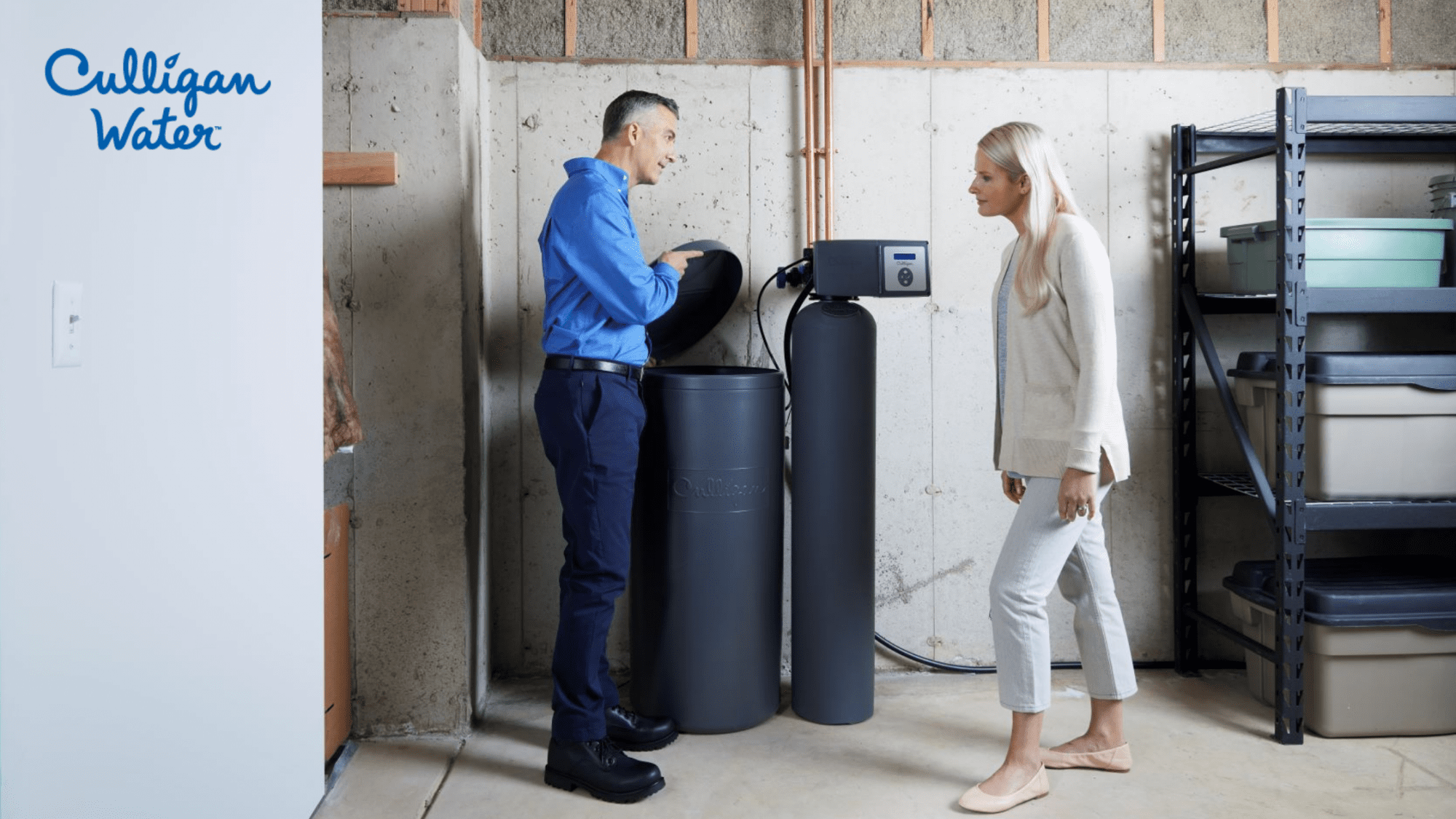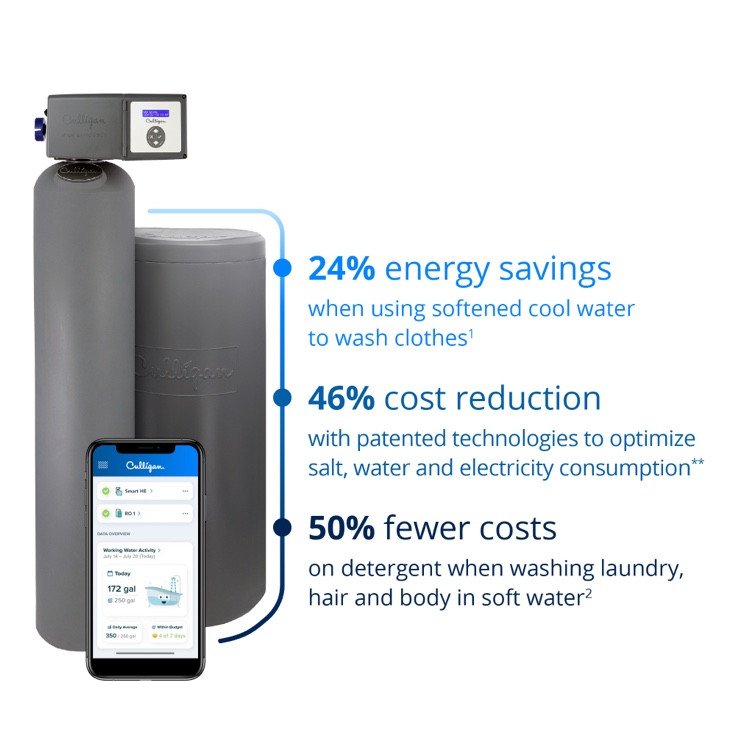Frequently Asked Questions About Water Softeners
Find answers to common questions asked about water softeners, including function, benefits, installation and maintenance.
Posted in
Culligan Cares,
Culligan Nation,
Culligan Solutions,
Hard Water,
Healthy Home,
Sustainability,
Water Softener,
Water Treatment

Do you have hard water or poor water quality? Find out with our free water test from your local Culligan water expert.
Did you know that hard water occurs naturally in more than 85% of homes nationwide? With those odds, it’s very possible that your home is being affected by this common water worry. Fortunately, water softening offers a simple solution.
If you're considering a water softener for your home, you may feel like you have a million questions. Here are some of the most frequently asked questions homeowners have about water softeners.
Water Softener FAQs
What is hard water?
Hard water contains dissolved minerals like calcium and magnesium. When this water dries, minerals stick to everything water touches — including your plumbing, hair and skin.
According to the Water Quality Association, hard water contains dissolved minerals above one grain per gallon (GPG), though relative levels of hardness have been established and are as follows:
- Soft - less than 1 GPG
- Slightly hard - 1 to 3.5 GPG
- Moderately hard - 3.5 to 7 GPG
- Hard - 7 to 10.5 GPG
- Very Hard - 10.5 and higher GPG
What are the effects of hard water?
The presence of hard water in your home results in:
- Limescale buildup around faucets or showerheads
- Soap scum on shower walls, bathtubs, sinks and other fixtures
- Plumbing and pipe corrosion
- Streaky or spotted dishes
- Stiff, scratchy laundry
- Irritated, dry skin or dull, lifeless hair
- Decreased efficiency of appliances and more frequent breakdowns
- An increase in the amount of soap and detergent needed for cleaning
How does a water softener work?
Water softening utilizes a process called "ion exchange" to remove dissolved minerals such as calcium and magnesium.
These minerals can't be trapped by a filter, so a molecular reaction is required. Water softeners have resin beads that hold onto sodium. And as hard water flows through the resin, the sodium is swapped for the hard water minerals. The hard water minerals are trapped inside the softener so they never reach your skin, hair or plumbing fixtures.
Featured Product: Aquasential™ Smart High Efficiency (HE) Water Softener

The world’s most efficient water softener*, the Aquasential™ Smart HE Water Softener, reduces hard water minerals to benefit both you and your home. Water-using appliances last longer, dishes get cleaner and your clothes, hair and skin become softer, too. Smart technology provides salt refill alerts and insights on product usage and performance through the Culligan Connect™ App.
What is the difference between softening and filtering water?
You don't have to be a water expert to understand the basic principles behind water softening and water filtration. Here's an abridged version of what happens when you soften or filter water.
Softening water involves a process called "ion exchange" to remove dissolved minerals such as calcium and magnesium that can't be trapped in a filter bed. Softeners contain resin beads with sodium attached. As water enters the tank, dissolved calcium and magnesium are attracted to the resin. The resin swaps the sodium in exchange for the dissolved minerals. Which helps reduce impurities in the water.
Meanwhile, filtering water involves the separation of particles from H2O. By passing water through a "filter bed" or "media bed," these granular particles are trapped and cleaner water flows to your tap. Water filters reduce a wider array of contaminants** than water softeners.
What is the difference between a water softener and a salt-free water conditioner?
A salt-free water conditioner is an alternative technology to traditional ion-exchange water softeners that use salt.
Unlike water softeners, salt-free conditioners do not reduce hard minerals in water. Instead, they chemically transform the magnesium and calcium, “conditioning” the minerals so that they do not cling to surfaces.
A Culligan salt-free water conditioner may be an effective solution if:
- You are primarily concerned with the negative effects of scale formation
- You live in a brine-restricted area
However, if you want cleaner dishes, brighter laundry, softer hair and skin, reduced soap usage and a longer lifespan for your appliances, a water softener would be a better choice.
Is it safe to drink softened water?
Yes. For nearly everyone it is safe to drink softened water. Moreover, you will not be able to taste the salt in a properly functioning water softener.
Some people are concerned that drinking softened water will increase the level of sodium in their diet. But the amount of sodium added to water during the softening process is low. If sodium levels remain a concern, combining your water softener with a reverse osmosis drinking water system can help to reduce salt and potentially harmful contaminants.
Do water softeners remove essential minerals from drinking water?
No, you will not miss out on any essential minerals by using a water softener.
Calcium and magnesium are both important to optimal health. However, food is our main source of consuming these minerals – not water. If you would like to add more calcium and magnesium to your diet, drinking hard water is not the solution.
In fact, the calcium and magnesium found in hard water cannot be properly digested. So, reducing their presence in drinking water will not hinder your proper intake of these minerals.
Where is a water softener installed?
Your Culligan water softening system will be installed on a level surface, near where water enters the home. If your home has well water, a drain and power source should also be near the softening system.
Here are a few tips to keep in mind when determining the right location for your water softener:
- The system should be out of the way but still accessible to your home’s plumbing system. For most people, this means the basement, garage or mudroom.
- Make sure that when you settle on a spot, it’s in an area that won’t be exposed to freezing temperatures that could damage the system.
- Depending on the type of water softening system you choose to install, there are drain proximity, electrical and piping connection requirements – all things that your Culligan water expert will help you with during installation.
If you’re replacing an old softener, Culligan water can remove it and haul it away for you at no additional cost.
Does a water softener require maintenance?
Yes, to continue operating at peak performance, a water softener needs regular maintenance. Which fortunately doesn’t require a lot of work.
Have your local Culligan water expert perform an annual inspection on the equipment to extend its lifespan and decrease future repair costs. Part of this inspection will include water testing. Which helps to identify other contaminants that may impact operation.
Water softeners are usually trouble-free. Especially if salt levels are regularly monitored. Culligan water can help with scheduled salt delivery service that checks over the unit and saves you from transporting and lifting those heavy bags. Your Culligan water expert will even remove and recycle the used salt bags.
But if you prefer to do it yourself, make sure to use quality solar salt. That should lessen another issue — salt bridging in the brine tank.
A salt bridge is a layer of hardened salt crust. If you suddenly lack soft water or your softener stops using salt, you should check the brine tank before calling for service. High temperatures, humidity or poor salt quality can create a bridge and prevent the softener's resin beads from regenerating.
In clearing salt bridges, use caution. Improper cleaning can puncture a hole in the wall of your water softener.
What is the lifespan of a water softener?
A high-quality water softener can last decades if maintained properly.
However, there are a few factors that can affect the lifespan, such as how often it’s used and the quality of your water. For example, if your home currently has extremely hard water or well water, your water softening system may need to be replaced sooner.
Once your water softener is ready to be regenerated, a Culligan water expert will come to your home to swap out the tank for a brand new, recharged unit. Regeneration takes place at Culligan water. So there’s no salt or discharge at your home or in your community.
What size water softener do I need?
Water softener size/capacity refers to how much the system can handle before regeneration is necessary. Capacity also impacts the amount of salt needed over time to make sure that the device can continue to treat water hardness.
The exact size/capacity of the water softener needed in your home depends on a variety of factors, including:
- The hardness of your water
- The service capacity from your well or municipal water supply
- Your typical household water usage
- Overall flow rate
Ultimately, selecting the best water softener for your home doesn’t have to be complicated. Working with your local Culligan water expert is a quick and easy way to find the correct size for your household. Getting this right is important for ensuring the best water quality and maximum efficiency.
Getting Started
At Culligan water, we have more than 85 years of expertise in water problems and solutions, serving 50 million customers per year. Our innovative systems are built to last. So you can feel confident that you can enjoy your soft water for many years to come.
Didn’t find the answer you were looking for? Don’t fret. The experts at Culligan water are available to answer every question left on your list.
For more information about water softening or Culligan water products, contact your local Culligan water expert or schedule a free water test today!
*HE Softener when configured with proportional upflow brining with Aqua-Sensor® technology. **Contaminants may not be in your water.
